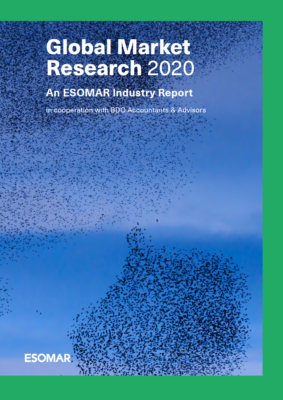This article, divided into two part due to length, is extracted from the 2020 Global Market Research report, where you can find detailed information on the insights industry for the world’s countries. Considered a must-have in the professional’s toolbox, this year’s edition of the Global Market Research report explores a more complete picture of the insights industry beyond the established market research and includes the tech-enabled side of data and analytics. Get the full report here (free to ESOMAR members)
Remote and passive forms of data collection have been around for some time. Recent global events, more specifically social distancing rules, have only accelerated this trend. We asked the experts to identify the most significant developments.
A universe of opinions
Remote data collection made most of its breakthroughs years ago, but the current environment insights professionals suddenly have to deal with underlines the importance of digitised, remote consumer intelligence.

Kantar Insights, South Africa
“It’s never been as important to go where respondents are”, says Kyle Findlay, Senior Data Science Director – Innovation, Kantar Insights, South Africa. “Traditionally, this might have meant intercepting them while they are out and about or knocking on their doors, but nowadays it means speaking to them on the platforms where they spend their time and in the way that they are used to communicating. Chatbots and conversational AI are a particularly exciting area for me as they allow us to have more natural conversations with people in the channels that they are already using, such as Facebook, WhatsApp and WeChat.”
A whole new data source
When it comes to asking questions for market research purposes, “online is the more popular way, even in countries where the internet penetration is lower than in developed countries”, says Michalis Michael, CEO of DigitalMR, a tech company that uses artificial intelligence for market research and customer insights. Michael thinks private online community platforms are leading the way here, using both qualitative and quantitative tools. “Social intelligence is a whole new data source on its own.”

Streetbees
According to Tugce Bulut, Founder and CEO of ‘next gen’ market research startup Streetbees, there is so much data out there that the challenge isn’t so much on collection though. “The greatest breakthroughs currently happening – and can be expected from – are on the analytics side, not data gathering. That’s where the technology is needed. Machines are required to do the heavy lifting when it comes to making sense of all this data – pulling out the insights and providing the user with actionable, tangible results.” She adds that companies such as Canvs, Verto, Hypergiant, Babylon Health and Domo are really investing in this area. “Now is the time for businesses to really embrace technology, particularly in the insights industry – but it can’t just be startups doing so, all businesses, no matter the size or age, must leverage the use of digital technology in order to provide value to their clients.”
Three trends
Nikki Lavoie, Managing Director of ‘human experience experts’ MindSpark Research International, sums up the most important changes she’s witnessed recently:

MindSpark Research International
A. Clients are more willing to give new methods a try – and many are seeing the benefits.
“As a practitioner specialising in global and multi-country methods, sometimes remote data collection was the only way to reliably collect data from certain regions without blowing the budget. It was previously a struggle to get clients to trust these approaches. Now that they’ve been given a nudge that didn’t come from a supplier, clients are more able to objectively evaluate these techniques.”
B. People are becoming more comfortable with technology.
“This improves incidence rates of those we seek to recruit as participants. Though it’s still important to be mindful of accessibility in all forms (including pervasiveness of tech) and plan for user error, we are certainly seeing a benefit to all of those Zoom meetings everyone’s been participating in.”
C. The technology itself can test new integrations.
“While the systems themselves have been robust for some time, the increased adoption of them leads to more technological hand-shaking, which can lead to increased efficiency and ROI for clients who are using things like knowledge databases, data lakes and other existing data collection tools.”
The new and the not so new

Michael feels that most innovation is brought to the industry by younger, smaller and more agile companies as opposed to the established multinationals. Indeed, Lavoie sees new players on the scene who are looking to capitalise on the need to go digital/remote. However, she also observes that much of the work has already been done by some relatively established research companies. “Those who are bulking up their capabilities to respond to this change in data collection are adding AI and machine learning aids to classify and categorise incoming data brought in from their existing tools. And they, too, have been around for a while.”
In Findlay’s experience at Kantar, there are a lot of startups doing interesting things but they all focus on brands and businesses first. “The paradigm that they work with is one of general business rather than market research specific. As a result, we find that we always need to tweak off-the-shelf solutions in very specific ways to better suit our industry’s unique needs.”
Bulut agrees that whilst social media listening and monitoring tools have come far over the past few years, they have limitations. Most notably: “We all know that the image we create for ourselves online is filtered.” She believes that while there’s a wealth of insights to be taken from them, it won’t provide a true, authentic understanding of the individual. “There is no way to unlock the unconscious drivers when purely looking at online behaviour. This is why there’s a need for versatile solutions that can be adapted for different channels, or can be used in conjunction with other tools.” Bulut expects an increase in acquisitions of these companies, by much larger insights businesses that want to strengthen their overall offering to clients.
Accurate digging
According to Michael, Reuters predicts that the total social listening and analytics market will be US$ 16 billion by 2023, up from US$ 5 billion in 2018 (according to ESOMAR). “Our industry came a long way since 2010, when social intelligence was non-existent in market research projects. Some clients are already considering replacing their brand health tracking surveys with social listening trackers.” Indeed, Bulut expects the technological innovations to have major consequences. “Surveys as we know them will soon be a thing of the past, and face to face surveys will all but disappear – they were already a dying form of research but the pandemic has simply accelerated this move. So much of our lives are online now – we need to interact with consumers in a way they feel comfortable with, that comes naturally to them. Capturing their decisions, feelings and experiences in the natural flow of activity cannot be done with established research methods.”

DigitalMR
Findlay has a nuanced view on these developments. “A few years ago, we thought that social media monitoring might replace many types of data but we’ve found that they actually fulfil a specific role. Depending on the type of social data, it’s often not as in-depth as we want in market research. Nor does it capture the way that brand owners think about their brands. Instead, it captures the way that consumers talk and often a lot of work needs to be done before the gap can be closed between those two paradigms – if it can be closed at all with just that data alone. Social data has turned out to be a complimentary rather than supplementary source in many cases.”
Lavoie goes further: “I don’t have a crystal ball, but I’d say that passive methods linked to social media are likely to actually decrease in market share. There is a big battle going on for ownership of data and transparency around that ownership. Clients – and the social media networks themselves – are shying away from anything that is not explicitly communicated to users regarding their data.” That said, she thinks there’s a lot of room for passive metering to make giant leaps forward. “This approach is already able to do some phenomenally accurate digging.”
Expect soon Part 2 of this interesting article to delve deeper on the requirements for automation of the industry, what limitations it should still overcome and the way forward.


